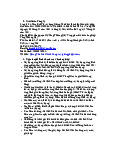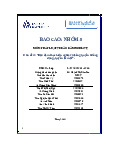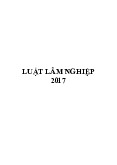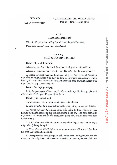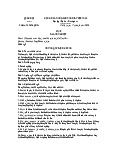



















Preview text:
R ETAIL PRODUCT M A N AG E M E N T
BUYING AND MERCHANDISING Rosemary Varley Artwork by David Gillooley
LONDON & NEW YORK viii C O N T E N T S Discussion questions 137 References and further reading 138
9 Allocating space to products 139 Introduction 139
The objectives of space allocation 140
Measuring retail performance in relation to space 141 The value of retail space 142
Allocating space on the basis of sales 144 Space elasticity 144
Allocating space according to product profitability 146
Practical and customer considerations 147 Space allocation systems 149 Store grading 149 Summary 151 Review questions 153 Discussion questions 154 References and further reading 154 10 Store design 155 Introduction 155
The interior decoration of a store 156 Materials 156 Atmospherics 158 Lighting 159 Signage 160
Store design and the corporate image 161 The exterior design 161 Location 164 Store image 165 The retail brand 166 Lifestyle retailing 166 Planning retail designs 166 Flagship stores 167
The strategic role of store design 167 Summary 168 Review questions 169 Discussion questions 170 References and further reading 170 11 Visual merchandising 171 Introduction 171 Visual merchandising 171
The scope of visual merchandising 174 Fixtures and fittings 174 Product presentation 179 Store layout 180 C O N T E N T S ix Displays 183 Summary 188 Review questions 189
Discussion questions and learning activities 190 References and further reading 190
12 Product management in non-store retailing 191 Introduction 191 Non-store retail formats 191 Home shopping 192
Product management implications 193 Product presentation 193 The selling environment 195 Pricing 195 Service 196 Convenience 197 Order fulfilment and delivery 197 Multi-channel retailing 200 Summary 202 Review questions 203 Discussion questions 203 References and further reading 203
13 International aspects of retail product management 205 Introduction 205
International retailing as a strategy 206
Product range: standardise or adapt? 206
The influences on different product strategies 207 Unavoidable adaptations 207
Organisation for product management 208 Local sourcing 209 Global sourcing 209 Ethical sourcing 212 Summary 213 Review questions 214 Discussion questions 214 References and further reading 214 Appendix 1
A case study of buying operations at Boots the Chemist 216 Appendix 2
A case study of the Olympic Museum shop 226 Appendix 3 A case study of New Look 234 Index 241 chapter eleven VISUAL MERCHANDISING INTRODUCTION
The relationship between a retailer’s product positioning strategy and the
branded store environment was explored in the previous chapter; however,
the store environment has to fulfil operational objectives for the retailer in
order to support buying and merchandising activities. The product has to be
presented on fixturing that is appropriate for the merchandise, and the
merchandise itself should be displayed in a way that enthrals customers.
After all the product management work that has gone into planning the
ranges, selecting the products, liasing with suppliers and getting the physical
product through the supply chain, the product is now handed over to store
managers, who provide the best opportunity for the product to sell. This
chapter concentrates on the direct relationship between the physical product
and the store elements that contribute to the product presentation process.
The concept of visual merchandising provides a useful framework for the
discussion of this interface, as the product range make its entrance into customer space. VISUAL MERCHANDISING
Visual merchandising is a commonly used term for the aspect of product
management that is concerned with presenting the product within the store
to its best advantage. Visual merchandising has often been used as a
synonym for display in retailing, but in today’s retail industry the term 171 172
V I S U A L M E R C H A N D I S I N G
incorporates a much wider brief. In the words of the editor of VM Insight
trade magazine (Hall 1999): ‘it is about taking the product and using it to
let the entire retail environment speak’. Visual merchandising combines a
commercial approach with a design approach within the store environment,
to support product management objectives and to maximise the efforts of
the buying teams. Visual merchandising also contributes to the strategic
aims of the retailer sending out clear messages to consumers about what
they can expect from the retailer, and that the brand values of the retailer
reflect the shopping experience values of the customer.
Visual merchandising plays a much greater part in the product
management process in some retail sectors than others. Fashion and home
furnishings have always devoted considerable resources to display, but even
in a grocery superstore elements of visual merchandising can be found,
and indeed some grocery retailers have used visual merchandising as a
way of providing interest to the customer and of differentiating themselves
from their competitors (see Box 11.1). BOX 11.1
REGIONAL SUPERMARKETS WITH A DIFFERENCE
The grocery supermarket sectors of most European retail markets are highly
concentrated. In the UK, the grocery sector is dominated by retail giants Tesco,
J.Sainsbury, Asda and Safeways. Below this ‘premier league’ of operators, a number
of smaller, regional chains are managing to survive. One such retailer is Morrisons.
Founded in 1899 by William Morrison, the father of the current chairman, the
company has survived until recently as a regional grocery supermarket chain, with
the majority of its stores covering the North of England. Morrisons’ stores offer a
wide product range in both foods and non-food items, half of which are sold under
the Morrisons brand. The stores are supported by modern retail operations and a central buying organisation.
In fast-moving consumer goods retailing, differentiation is not easily achieved
however, Morrisons have chosen to use visual merchandising as a route to making
its stores a little different to the other grocery stores that it competes with in the
region. The careful attention to store design begins with the architectural detail of
the stores; each is visually different and complementary to local architectural styles
and materials. For example, the Sheffield store is housed in disused Yorkshire stone
army barracks, which makes for a sturdy and impressive backdrop to the store.
Inside, Morrisons have adopted a ‘market street’ concept, where a number of stall-
type service counters, complete with striped awnings and street signs, hark back to
the time of the traditional specialist shops, including a butcher, a fishmonger and a
baker. The signage and canopies help to create the atmosphere in this part of the
store, where customers are encouraged to interact with store personnel and gain the
individual attention often lacking in the supermarket shopping experience. Other
themed areas include modern food combinations such as American donuts and
popcorn, curry selections and salad bars, whilst the fresh produce area returns to the
traditional theme, with fruit and vegetables displayed on old-fashioned wooden carts.
V I S U A L M E R C H A N D I S I N G 173
Responsibility for visual merchandising
within the retail structure
Responsibility for this part of product management at board level varies.
Lea Greenwood (1998) found that visual merchandising was under the
remit of directors of visual merchandising, corporate communications or
promotions. In some retail organisations a team of brand managers co-
ordinates the visual merchandising effort with other promotional activities,
so that it becomes part of the marketing activities. In fact elements of
visual merchandising (particularly the use of point of sale material and
photographic imagery) are sometimes sloppily referred to as ‘in-store
advertising’. The structure beneath the director is sometimes unclear, but
a visual merchandise manager supported by area teams is a format
frequently used in multiple retailers. In smaller retail companies, somebody
based in the store may be partly or wholly responsible for visual
merchandising. Visual merchandising at the implementation level is a
creative activity and usually attracts people with a design training or
background, although specific training for this aspect of retailing is
becoming more common, (see Box 11.2). BOX 11.2
A NEW QUALIFICATION IN VISUAL MERCHANDISING
A less than inspiring shopping experience within the stores has been suggested as one
of the contributing factors to the downfall of Marks & Spencer plc in the late 1990s.
However, the company has been taking steps to address this problem. Along with John
Lewis Partnership, Marks & Spencer has been a key instigator in the development of
the UK’s National Vocational Qualification in visual merchandising which was
launched towards the end of 1998. One of the difficulties associated with visual
merchandising is that it requires creativity and commercial acumen, combined with
specific skills which traditionally have been picked up during a kind of informal
apprenticeship. The theoretical framework of visual merchandising can be provided by
college courses, but in-work training allows for a wider appreciation of the role, from
the need to comply with health and safety regulations, to gaining an understanding of
how visual merchandising plans link to buying and merchandising strategies. As the
need to create better store environments increases, formal recognition of the
qualifications of those who work at store level is a positive move for the retail industry. (Source: Young 2000)
Visual merchandising as a support for a positioning strategy
In a retail environment that is increasingly saturated, competitive and subject
to inter national competition, visual merchandising is a way of
communicating and differentiating the retail offer. It must be an integral
part of any strategy in which a retailer attempts to position or re-position 174
V I S U A L M E R C H A N D I S I N G
the retail offer in the mind of the consumer. It is apparent, then, that
visual merchandising is frequently used by multiple retailers to strengthen
the retail brand, but a highly centralised and inflexible approach to visual
merchandising may not be appropriate in all circumstances. Figure 11.1
considers centralised and decentralised approaches to visual merchandising.
Figure 11.1 Visual merchandising: local and centralised approaches
THE SCOPE OF VISUAL MERCHANDISING
The discussion above has promoted the idea that visual merchandising
encompasses a wide range of activities, but has not detailed what specific
activities are included in the visual merchandise process. Across all retail
sectors, visual merchandising may include all or some of the elements outlines in Figure 11.2.
Figure 11.2 The scope of visual merchandising FIXTURES AND FITTINGS
The way products need to be presented and displayed within the store will
largely determine the choice of fixturing. The principle types of fixtures
are illustrated in Figures 11.3–11.7. Gondolas
The term gondola refers to a system of shelving which offers stacked
merchandise to the customer in a longitudinal presentation (Figure 11.3).
V I S U A L M E R C H A N D I S I N G 175
The gondola is used in the ‘grid format’ where consumers move along aisles
between gondolas, which offer merchandise on both sides. The end of the
gondola is a particularly effective in attracting customers to products as they
slow down to turn the corner to view merchandise on the other side.
Figure 11.3 The gondola Rounders
As the name suggests the rounder fixture offers merchandise in a circular
presentation (Figure 11.4). The merchandise might be hung on a series of
prongs, as in the case of belts or bubble packed products, or the rounder
may be a more solid structure, showing the variety available in a
merchandise type. Gap uses this type of fixturing to show all the colours
available in basic tops or sweaters Four-ways
Four-way fixtures offer the retailer flexibility when a degree of co-ordination
is needed. The fixture offers a combination of front facing merchandise
presentation, with the space efficiency of side hanging (Figure 11.5). Shelving
Wall space is useful for incorporating the general display of merchandise
within the overall interior design of the store (Figure 11.6). Levi’s, for
example, used a system of wooden wall shelving which allowed a large
quantity of merchandise to be stacked from floor to ceiling, whilst offering 176
V I S U A L M E R C H A N D I S I N G
Figure 11.4 A rounder fixture
Figure 11.5 A four-way fixture
V I S U A L M E R C H A N D I S I N G 177
interest by showing all the alternative shades of denim. However, as this
type of shelving arrangement became popular with other casual-wear
retailers, Levi’s introduced a new ‘wavy’ shelf design in its flagship store
(VM Insights April 2000) in a move to retain their innovative image.
Figure 11.6 Shelving
Bins, baskets and tables
Bins and baskets are normally used to house large quantities of merchandise.
They are effective for small items and for heaps of promotional merchandise.
They may be filled with one type of product, or the customer may be invited
to rummage through a variety of products retailing at a particular price
point. Promotional merchandise can also be stacked on tables, which provide
flexibility in terms of space allocation and display area. However, tables can
also be used in a more elegant display of product, as shown in Figure 11.7.
The increased use of self-service in retailing has meant that the use of drawers
and cabinets has decreased, but they may still be used for very functional
merchandise that does not really need displaying or in instances where
merchandise needs protection. For example, traditional hardware stores that
sell screws and nails by weight, rather than pre-packaged, keep this type of 178
V I S U A L M E R C H A N D I S I N G
Figure 11.7 Bins, baskets and tables
merchandise in drawers. Watches and jewellery are often housed in glass
cabinets in order to prevent damage and theft.
Many retailers have their own customised fixturing and their own
customised terminology. Marks & Spencer have a basic unit of fixturing
called the ‘Luton gondola’ named after a prototype successfully trailed in
the Luton store. Fixturing should have a degree of co-ordination throughout
the store so that they can be considered in ‘families’, using the same type
of materials, whether it is chrome, wood, acrylic or melanin, and the same
set of design features. In all retail circumstances the fixturing should
complement and not compete with the merchandise, although the fixturing
may be used to reinforce the retail brand image. Fixturing also needs to be
flexible, so that an ever-evolving product range can be successfully
accommodated. Many modern systems are modular, which enables a great
number of alternative combinations to be built.
V I S U A L M E R C H A N D I S I N G 179
Figure 11.8 A movable hanging fixture PRODUCT PRESENTATION
The way in which products are presented as routine will depend on the
type of fixture available (see above) but essentially can include:
• vertical stacking, for example, for magazines or CDs;
• horizontal stacking, for example, for tinned foods or folded garments;
• hanging—on hangers or hooks;
• hanging—mounted on card or bubble packed.
Merchandise presentation is largely determined by product category or
end use of product, but in some instances other product characteristics
may bear a relation to the presentation method. Colour, for example, is
often used effectively, and many clothing and home furnishings retailers
incorporate a corporate colour palette into the buying plan so that different
product categories can be presented together.
Retailers may group merchandise together according to price levels or
even sizes. Many variety stores use a system of price lining where
merchandise is selected to fit into key price points, for example, men’s ties
at £7.99, £9.99, £15.99 and £19.99. Women’s clothing retailers may use
sizing groups such as petites, regular and ‘plus’; and charity shops generally
use product, sizing, then colour to provide some logic in their disparate
merchandise offer. There may also be a case of grouping products according
to levels of technical involvement; for example, PC World houses software
and accessories at the front of the store and the full PC systems are
positioned at the back of the store. The customer is faced with gradually
increasing product complexity as he or she moves through the store.
Product presentation can instigate a number of issues for other members
of the product management team. Fixturing may determine the size 180
V I S U A L M E R C H A N D I S I N G
variation a retailer offers, for example a small convenience store may not
find it practical to stock family size cereal packets as they require such tall
shelves; it would be preferable in this type of retailer to offer a smaller
pack size and another product item in the same available space. The method
of presentation may also determine the packaging or ‘get-up’ of the product;
for example, a folded shirt is likely to need board and pins or a paper sash
around it to keep it looking neat, but all these add to the cost of the item.
Small items, such as stationery products, are much more manageable when
bubble packed or mounted on card and hung on a wall fixture. It may be
necessary to attach an illustration of the product in use if it has little ‘hanger
appeal’; for example, a swimsuit tends to look like a crumpled rag on the
hanger, and most uncooked pre-prepared meals look unappetising and rely
on the photograph on the package to encourage purchase.
New approaches to point of purchase presentation methods have been
part of the orientation towards category management in the management
of customer demand. Dedicated product fixturing can provide clarity and
logic to the product presentation, whilst incorporating suggested
complementary and impulse purchases in the arrangement. STORE LAYOUT
Visual merchandising also encompasses the design of a store layout. A store
layout will be heavily influenced by the assortment and variety on offer (see
chapter one) and will be constrained by the size and structure of the shop
itself. The layout used will also determine or be dependent on the type of
fixturing used. There are a number of different approaches to store layout,
although they are all designed with the intention of moving customers to
every areas in the store in order to expose them to the full range of products.
A common store layout has fixtures positioned in the form of a grid
(Figure 11.9). This method maximises the use that can be made of the
available space and provides a logical organisation of the products on offer.
However, it is rather mechanical in its approach, and rows of gondola type
fixtures with aisles between them can lack interest. A grid layout, by the
nature of the large fixturing used, is also relatively inflexible.
An alternative approach is to place the fixtures in a more random pattern.
This type of layout is appropriate when variety in the fixturing is needed
and when the shopping process involves browsing rather than a more
systematic product selection process. Referred to as a free form or a free
flow layout, this kind of arrangement can successfully incorporate a mix of
small gondolas, hanging rails and shelving units. Although the free form
layout generally offers more opportunity to create interest than the grid
layout, a unending mass of fixtures set out in a random fashion can look
chaotic and for large expanses of retail space, such as in a department
store, some attempt must be made to break up the space and create pockets
of interest for the customer. According to Din (2000), the product areas in
a free form layout should not be too large or too deep, to prevent customers
from feeling trapped (see Figure 11.10).
Figure 11.9 A grid layout
Figure 11.10 Free form layouts
V I S U A L M E R C H A N D I S I N G 183
Where the merchandise range is limited or in situations where a high
level of personal selling is desirable or necessary, a ‘boutique’ layout could
be used. This layout surrounds the customer with merchandise, most of
which is displayed in or on wall fixturing, with one or two other central
fixtures offering interest or, perhaps, housing the till. In larger stores a
definite walkway or ‘race track’ is incorporated into the layout, guiding the
customer between the main classifications of merchandise, which are often
set out in free form or short grid fixturing.
Modern layouts are generally more airy, with voids replacing walls and
glass replacing solid partitioning. ‘Decompression zones’ are used to give
shoppers time to relax and refocus their attention, for example at the front
of the store or near escalators. Vertical access and visibility is also becoming
increasingly important as a means of encouraging customers to multi-level
retail space, as the amount of available ground floor space decreases in
prime shopping centre locations. Complementary products
Within the overall store layout, decisions concerning which categories of
merchandise should be place next to one another need to be determined.
This is where the principles of space allocation and store layout are
intertwined. A store layout must provide a logic to the customer, whilst
helping the retailer to achieve its own objectives in terms of exposing the
store visitor to as much of the product range as possible and to increase
the value of the transaction of each customer. This is done by getting
customers to buy additional items that might be linked to the intended
purchase or by encouraging them to ‘trade up’ by buying a higher value
item than they had originally intended to buy, or they may be tempted to
buy a completely unplanned purchase in a moment of impulse.
Although the achievement of this kind of retailer objective might be viewed
as a manipulation of customers, more and more shopping trips are made
with only a vague plan or ‘list’. Introducing product suggestions on the shelf,
or by virtue of the store layout, could be viewed as a provision of retail
service—making the shopping experience easier and more convenient for
the time-pressured customer. In supermarkets customers find dips displayed
alongside Nacho chips and salad dressings alongside pre-prepared salads. In
a department store accessories will be located in their own department for
customers who have a specific purchase in mind and alongside larger items
like suits or coats in order to encourage impulse buying. DISPLAYS
Displays can normally be broken down into three different types: on-shelf
displays, off-shelf displays and window displays. On shelf displays are the
‘normal’ displays around the store that show all the different variations of
product on offer in some kind of logical sequence. The various presentation
methods used in on-shelf display were discussed in the section concerning
product presentation earlier in the chapter. 184
V I S U A L M E R C H A N D I S I N G Off-shelf displays
These displays are designed to have additional impact by showing the product
as it might be used, or perhaps alongside other products to suggest
complementary purchases. Displays can also be considered as visual features
that create interest or excitement within the store. They might be placed on
walls, within alcoves or at the end of a fixture such as a gondola. Whilst on-
shelf displays have to combine functionality with aesthetic sensibility, many
off-shelf artistic displays are not used in the routine selling process and therefore
can be constructed to make a significant visual impact. They are often very
artistically arranged and only changed by the visual merchandise team. They
may incorporate ‘props’, which are not part of the product range for sale, or
they might be based on a body form or mannequin (see Box 11.3). BOX 11.3 BODY FORMS
Products that we wear can look entirely different with and without a body in them.
Retailer used a wide range of body forms in clothing displays, from headless torsos
for tops and bum-forms for jeans, to stylised figures and lifelike mannequins for full
outfits. Body forms can be a much more important part of a store design that a
glorified coat hanger. Customers relate strongly to body forms because of their
human imagery and so the choice of mannequin is a crucial decision in order to send
the right kind of messages to the target customer. Body forms are an expensive part
of the visual merchandising tool kit, and so ideally should have lasting appeal. Using
the features of role models, such as supermodel Jodie Kidd or pop celebrity Liam
Gallagher, is an effective way of communicating with potential customers.
In contrast, off-shelf displays are also used for promotional purposes
and may well incorporate a fixture such as a dump bin, which offers the
functional purpose of housing an increased quantity of the promotional
item with the visual impact of a tonnage display (see Figure 11.13).
In 1981, Rosenbloom described a number of different display types,
including open, theme, lifestyle, co-ordinated and classification dominance
displays. Nowadays, most on-shelf displays can be regarded as open displays
since the customer is encouraged to inspect, and handle products unaided
in most retail situations. However, many of the other display classifications
are still seen regularly in retailing, most commonly for off-shelf, artistic displays.
The themed display can be used for a local event, such as a theatre
production or a film release, and is commonly used for seasonal purchases.
Display props can be worked into the product theme, as shown in Figure 11.11.
Lifestyle displays offer the opportunity to incorporate a wide variety of
products. For example, a display based on the theme of a barbeque could
involve garden furniture—the barbeque itself, outdoor tables and loungers;
V I S U A L M E R C H A N D I S I N G 185
Figure 11.11 A themed display
kitchenware products—utensils, plastic crockery and tumblers, informal
cutlery; essentials such as charcoal and matches; food produce such as
marinades and sauces; accessories such as outdoor lighting and candles;
and books on the subject of barbeque building or barbeque cookery.
The ‘classification dominance’ display allows a retailer to show that it
has a very deep assortment of merchandise within a classification or
category. The photograph in Figure 11.12 shows how Salami sausages are
displayed to show the extensive range on offer.
At the opposite end of the scale a display can be very eye-catching if the
same product is used in a quantity that is much larger than normal. Referred
to by Levy and Weitz (1998:560) as tonnage merchandising, this type of
display is often used for in-store promotions (Figure 11.13).
The co-ordinated display often uses a colour theme to connect the
products being grouped together. It is quite common for lifestyle displays
to be colour co-ordinated in order to create additional impact. Texstyle
World, a UK-based soft furnishings category killer, uses colour themes in
both on-shelf and off-shelf displays to arrange its merchandise, rather than
grouping by product category. Other co-ordinating themes could be texture,
style or brand. Co-ordination can also be based around the end use of
product, sometimes referred to as idea orientated displays. DIY retailers
like B&Q use ‘projects’ to co-ordinate a seemingly diverse range of products
that will be used during a specific DIY task, and even have demonstrations
of projects in-store to get customers started. Similarly, grouping products
into meal ideas can stimulate unplanned purchases of components for a
new menu. Figure 11.14 shows a colour co-ordinated window display. 186
V I S U A L M E R C H A N D I S I N G
Figure 11.12 A classification dominance display
Figure 11.13 Tonnage merchandising
V I S U A L M E R C H A N D I S I N G 187
Figure 11.14 A colour co-ordinated window display
Product focus displays reflect the trend for spacious retail interiors. A
single product or a small group of products are displayed in isolation, leaving
the product and its juxtaposition with the space around it to create a visual
impact. This type of display is most frequently used for products with
prestige value because of the resource implication associated with a higher
customer space to merchandise space ratio.
The principles of design
Although the principles of design relate as much to the overall design of
the store as to a display within, it is perhaps appropriate to consider them
